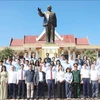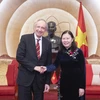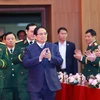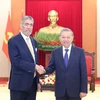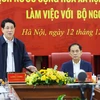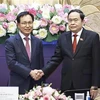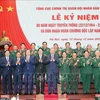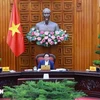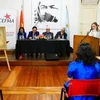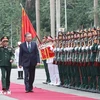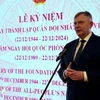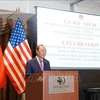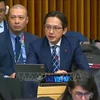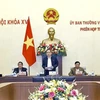The 43 rd ASEAN Foreign Ministers Meeting (AMM-43) wrapped up in Hanoi on July 20 after adopting a joint communique with the theme "Enhanced Efforts t owards the ASEAN Community: from Vision to Action”.
Following is the full text of the joint communique:
INTRODUCTION
1. We, the Foreign Ministers of the Association of Southeast Asian Nations (ASEAN), met at the 43 rd ASEAN Foreign Ministers Meeting (AMM) from 19-20 July 2010 in Ha Noi, Viet Nam . His Excellency Pham Gia Khiem, Deputy Prime Minister and Minister of Foreign Affairs of Viet Nam and Chairman of ASEAN, chaired the Meeting. We had extensive, open and fruitful discussions to advance further ASEAN’s common efforts under the theme of the year 2010 “ Towards the ASEAN Community: from Vision to Action ”.
2. His Excellency Nguyen Tan Dung, Prime Minister of the Socialist Republic of Viet Nam, attended the Opening Ceremony of the 43 rd AMM and delivered his Opening Address.
3. Highlighting great achievements so far in moving towards the ASEAN Community and important decisions made at the recent 16 th ASEAN Summit in Ha Noi, Prime Minister Nguyen Tan Dung suggested 5 major areas that ASEAN Foreign Ministers could focus on, namely: i) undertaking concrete and feasible measures to accelerate the implementation of the Roadmap for the ASEAN Community by 2015 and other important plans, bringing the ASEAN Charter into full realisation as soon as possible and further promoting the “compliance culture” to ensure effective and timely implementation of ASEAN’s agreements; ii) further enhancing the role of ASEAN as the primary driving force for dialogue and cooperation on regional political security issues with a view to maintaining regional peace and stability; iii) broadening and deepening ASEAN’s external relations through frameworks of ASEAN+1, ASEAN+3, EAS and ARF, based on the guiding principle of serving the objective of ASEAN Community building and maintaining ASEAN centrality; iv) intensifying cooperation and coordination at regional and international levels to effectively address global challenges, especially the current global financial crisis, climate change, disaster management and disease control; v) enhancing ASEAN’s cohesiveness and unity, upholding ASEAN’s fundamental principles and “ASEAN way” in handling all issues of concern.
ASEAN COMMUNITY BUILDING
4. We noted with appreciation the successful outcome of the 16 th ASEAN Summit in Ha Noi on 8-9 April 2010, which gave strong impetus to the efforts of building a resilient, dynamic and sustained ASEAN Community. We reaffirmed our commitment to effectively implementing the decisions made by our Leaders, especially in expediting the process of ASEAN Community building and maintaining ASEAN centrality in an evolving regional architecture.
5. We were pleased with the significant progress made in implementing the Roadmap for ASEAN Community and the ASEAN Charter and reaffirmed our strong commitment to realising the ASEAN Community by 2015, which is politically cohesive, economically integrated and socially responsible.
6. We welcomed the adoption of the Communication Plans of all the three pillars of the ASEAN Community, and tasked the Committee of Permanent Representatives to ASEAN ( CPR) to work in close coordination with the ASEAN Secretariat to come up with a Master Communication Plan synergising all the three Communication Plans in order to enhance ASEAN’s coordination to promote the people’s greater awareness and participation in the ASEAN Community building process.
ASEAN Charter
7. We welcomed the speedy progress in implementing the ASEAN Charter, which constitutes the legal and institutional framework for the ASEAN Community and beyond. We noted with pleasure the smooth and effective functioning of the new organs and structures under the ASEAN Charter, especially the four Ministerial Councils and the CPR.
8. We noted with satisfaction the significant progress of the work of the CPR in supporting ASEAN to become a more rules-based intergovernmental organisation by concluding various guidelines, terms of reference (TORs) and rules of procedures (ROPs). We were pleased to adopt the TORs and ROP for the ASEAN Committees in Third Countries and International Organisations (ACTC) at this 43 rd AMM. We noted with appreciation that the Guidelines on the Use of the “ASEAN” name, Guidelines on the Use of ASEAN Emblem, Guidelines on the use of the ASEAN Anthem and the ASEAN Secretariat Financial Rules and Procedure (AFRP) prepared by the CPR have been adopted at the Sixth Meeting of the ASEAN Coordinating Council (ACC) in April 2010. We encouraged the CPR to continue its important work in implementing the ASEAN Charter by finalising the remaining guidelines, TORs, and ROPs expeditiously.
9. We reaffirmed the role of the ASEAN Intergovernmental Commission on Human Rights (AICHR) as the overarching institution for regional cooperation in human rights. We commended the AICHR’s efforts in finalising the Five-year Work Plan (2010-2015), which would lay out relevant practical programmes and activities for AICHR to carry out its mandate and functions. In this connection, we approved the high priority programmes and activities (2010-2011) of AICHR together with the indicative budget for that period, and requested AICHR to finalise and submit the indicative budget for the cycle of five years for us to adopt the Five-Year Work Plan (2010-2015). We stressed the importance of ensuring the effective operation of AICHR and the proper alignment with AICHR of ACWC and other ASEAN sectoral bodies dealing with human rights in conformity with the Terms of Reference of AICHR.
10. We were pleased with the progress that had been made in developing legal documents necessary for the full and effective implementation of the Charter . We tasked the senior officials to continue to work on these remaining legal documents with the aim of finalizing them by the 17 th ASEAN Summit in October 2010.
11. We further stressed the importance of bringing the ASEAN Charter into full realisation in all aspects while upholding the principles of the Charter, and therefore committed ourselves to working closely with relevant sectoral bodies in the three Community Councils to improve the working methods and complete a full legal framework for the ASEAN Charter.
Roadmap for an ASEAN Community
12. Noting with satisf action the significant progress achieved in the implementation of the ASEAN Political-Security Community (APSC) Blueprint , we agreed to further accelerate th e implementation process , particularly the programmes/activities in the 14 priorit y areas . We underscored the importance of enhancing the coordination amongst the various sectoral bodies under this pillar to promote an integrated approach in dealing with overlapping issues.
13. We were pleased to note that ASEAN Member States have been effectively implementing the programmes and measures of the ASEAN Economic Community (AEC) Blueprint with a view to achieving the AEC by 2015. We called on ASEAN Member States to further intensify efforts in intra-ASEAN economic integration and in implementing all economic integration commitments in accordance with the agreed timelines.
14. We noted with satisfaction r emarkable progress made in the implementation of ASEAN Socio-Cultural Community (ASCC) Blueprint, particularly in enhancing social welfare and development for women and children, responding to climate change and disasters, developing human resources, promoting ASEAN identity and awareness. We welcomed the outcome of the 3 rd ASCC Council Meeting, particularly the practical measures which would raise the awareness of ASEAN in the region and the world and create greater sense of belonging of our peoples to the ASEAN Community and protect our cultural identity and diversity.
15. We welcomed the progress report of the High Level Task Force on ASEAN Connectivity (HLTF-AC) and were heartened to note that the HLTF-AC is on track for the completion of the Master Plan on ASEAN Connectivity by the 17 th ASEAN Summit. We thanked the partner agencies, namely the Economic Research Institute for ASEAN and East Asia (ERIA), the Asian Development Bank (ADB), the United Nations Economic and Social Commission for Asia and the Pacific (UNESCAP) and World Bank for the assistance rendered in the drafting of the Master Plan. We also called for support from our Dialogue Partners, international organisations and other partners, for the ASEAN Connectivity Initiative and look forward to their future participation in the implementation of the Master Plan once it is adopted.
16. We were pleased with the progress in implementing the Initiative for ASEAN Integration ( IAI) Work Plan II (2009-2015). The effective implementation of the Work Plan, together with the three ASEAN Community Blueprints, will help move forward the community-building process in a more balanced, inclusive and sustainable manner. In this connection, we welcomed the outcome of the IAI Task Force Meetings on the IAI Work Plan II. We encouraged Dialogue Partners and Development Partners to actively contribute towards ensuring the fruitful outcome of the 3 rd IAI Development Cooperation Forum (IDCF-3) scheduled to be held later in 2010.
17. Fully aware of the great importance and necessity of narrowing the development gap among Member States in the ASEAN Community building process, we agreed to further intensify our efforts in narrowing the development gap in ASEAN to enhance ASEAN integration. Together with the implementation of the IAI, we agreed to strengthen cooperation in sub-regional areas including Mekong sub-regional frameworks (AMBDC, CLV, CLMV, ACMECS, GMS), BIMP-EAGA, IMT-GT, and others.
ASEAN Centrality in an Evolving Regional Architecture
18. We stressed the importance to maintain ASEAN centrality in the evolving regional architecture. To this end, we agreed to intensify our efforts to accelerate ASEAN’s integration and community building while proactively broadening and deepening ASEAN’s external relations and strengthening ASEAN’s role as the primary driving force in the existing regional mechanisms . We reaffirmed our Leaders’ guiding principles that any new regional framework or process should be complementary to and built upon existing regional mechanisms and the principle of ASEAN centrality. We also emphasised the need to develop ASEAN’s common strategies and stance vis-à-vis important partners and important regional and global issues.
19. We envisaged that ASEAN Community building would contribute to the building of a community in the wider region. We also reiterated that the regional architecture should be inclusive and be able to sustain the dynamic equilibrium of the region. The regional architecture must be shaped by harmony and cooperation in promoting regional peace, stability and prosperity.
20. We welcomed the expressed interest of the Russian Federation and the United States to join the East Asia Summit (EAS). We agreed to recommend to ASEAN Leaders at the 17th ASEAN Summit in Ha Noi in October 2010 to formally make the decision on inviting the Russian Federation and the United States to join the EAS with appropriate arrangements and timing. Such arrangements should be based on the promotion of existing EAS agenda and priorities. In this connection, we reaffirmed ASEAN centrality as well as the established objectives and principles of the EAS as a Leaders-led forum.
21. We welcomed the outcome of the 4 th A SEAN Defence Ministers’ Meeting (ADMM) on 11 May 2010 in Ha Noi which contributes to further strengthening defence dialogue and cooperation in ASEAN. In this connection, we supported the 4 th ADMM’s decision to convene the first ADMM Plus in Ha Noi in October 2010. We reaffirmed the importance of the ADMM Plus as an important component of a robust, effective, open and inclusive regional security architecture that would complement the work of the ASEAN Regional Forum and help ensure ASEAN centrality in regional efforts to deal with security issues.
ASEAN POLITICAL-SECURITY COMMUNITY (APSC)
Treaty of Amity and Cooperation in Southeast Asia ( TAC)
22. We welcomed the accession by Canada and Turkey to the Treaty of Amity and Cooperation in Southeast Asia (TAC) as a strong signal of their commitment to strengthening cooperation with ASEAN and to peace and security in the region.
23. We welcomed the signing of the Third Protocol amending the TAC scheduled to take place on 23 July 2010. The entry into force of the Protocol will provide a more inclusive nature to the TAC, enabling accession by, not only states but also regional organisations whose members are Sovereign States. We looked forward to its full ratification by all the High Contracting Parties and the early accession of EU/EC to the TAC once the Third Protocol enters into force.
24. Noting the request by some other countries to accede to the TAC, we tasked our senior officials to consider this matter in line with the Guidelines for Accession to the TAC and submit their recommendation to us. We further noted the need to implement the APSC Blueprint in Strengthening Cooperation under the TAC.
Treaty on the Southeast Asia Nuclear Weapon-Free Zone (SEANWFZ)
25. We underscored the importance of preserving Southeast Asia as a Nuclear-Weapon-Free Zone and free of all other weapons of mass destruction as enshrined in the ASEAN Charter and the SEANFWZ Treaty. We reviewed the implementation of the Plan of Action to Strengthen the Treaty on the Southeast Asia Nuclear Weapon-Free Zone (SEANWFZ) and agreed to exert greater efforts to ensure that various programmes and activities indicated in the Plan of Action are carried out. We agreed to continue to engage with the Nuclear Weapon States to encourage them to accede to the SEANWFZ Protocol as soon as possible.
26. We noted with satisfaction the progress in the implementation of the Plan of Action to strengthen the SEANWFZ Treaty by the adoption of the 64 th UNGA Resolution on SEANWFZ. We agreed that the threats of nuclear proliferation, wherever their sources are, must be effectively addressed without discrimination or any double standard.
27. We commended Viet Nam as the Chair of ASEAN in raising the profile of the SEANWFZ in multilateral fora including the 2010 NPT Review Conference and the 2 nd Conference of States Parties and Signatories to Treaties that establish NWFZ and Mongolia in New York this year and looked forward to the SEANWFZ interacting closely with interested Parties including other NWFZs to promote the goals of the NPT in our region and beyond. We welcomed Indonesia as the incoming Chair of the SEANWFZ Commission starting from January 2011 and her initiation to ratify the Comprehensive Nuclear Test Ban Treaty (CTBT) .
South China Sea
28. We reaffirmed the importance of the Declaration on the Conduct of Parties in the South China Sea (DOC) as a milestone document between ASEAN and China , embodying the collective commitment to promoting peace, stability and mutual trust and to ensuring the peaceful resolution of disputes in the area. We underscored the need to intensify efforts to ensure the effective implementation of the Declaration and looked forward to the eventual conclusion of a Regional Code of Conduct in the South China Sea (COC). In this connection, we welcomed the reconvening of the Meeting of the ASEAN – China Joint Working Group on the Implementation of the DOC in April, 2010 in Ha Noi and tasked our Senior Officials to work closely with their Chinese counterparts to reconvene the ASEAN – China Senior Officials’ Meeting on the DOC at the earliest opportunity.
29. We further stressed the importance of maintaining peace and stability in the South China Sea and encouraged the continued exercise of self-restraint by all the parties concerned and the promotion of confidence-building measures in this area. We emphasised the importance of all parties to respect the freedom of navigation in and over-flight above the South China Sea as provided for by the universally recognised principles of international law. We welcomed the commitment of all the parties concerned to resolving disputes in the South China Sea through peaceful means in conformity with the spirit of the DOC and recognised principles of international law, including the United Nations Convention on the Law of the Sea (UNCLOS 1982).
ASEAN Regional Forum (ARF)
30. We reaffirmed the role of the ARF as the primary forum at the Foreign Ministers’ level in enhancing political and security dialogue and cooperation in the Asia-Pacific region, and ASEAN as the primary driving force of the ASEAN Regional Forum (ARF) process.
31. Reaffirming the importance of realising the ARF Vision Statement which sets out the ARF’s vision of a peaceful and stable Asia-Pacific region, its purposes, functions and direction up to the year 2020, w e looked forward to the adoption of the Ha Noi Plan of Action to implement the ARF Vision Statement at the 17 th ARF which, inter alia, contains policy guidance for the ARF to further develop and implement concrete and practical actions. We also looked forward to the effective implementation of the Ha Noi Plan of Action and other ARF work plans, thus contributing to preserving peace and security in the region and to promoting the ARF as an effective entity and a key pillar in the evolving regional security architecture. We commended all efforts in the ARF to pursue preventive diplomacy (PD) at a pace comfortable to all Participants, while maintaining the mainstream of confidence building measures (CBM), and supported the initiative to develop an ARF Work Plan on PD in the following inter-sessional year.
Non-traditional security issues
32. Noting with satisfaction ASEAN’s ongoing cooperation in non-traditional security issues, we resolved to further enhance greater interaction and cooperation among relevant agencies of ASEAN Member States in addressing non-traditional security issues, particularly counter terrorism and transnational crimes, and maritime security. In this regard, we fully supported the implementation of the ASEAN Convention on Counter-Terrorism and its Comprehensive Plan of Action and encouraged the remaining ASEAN Member States to ratify as soon as possible the ASEAN Convention on Counter Terrorism (ACCT). We agreed to task our senior officials to continue the work to finali s e the ASEAN Declaration on Humanitarian Assistance to People and Vessels in Distress at Sea . We also tasked our senior officials to work closely with relevant sectoral bodies to help address these non-traditional security issues. We noted Viet Nam ’s proposal to host a Meeting of the ASEAN Chiefs of Homeland Security (MACHOS).
ASEAN Security Outlook
33. We took note of the Regional Seminar on the Preparation of an ASEAN Security Outlook (ASO) held on 7-8 June 2010 in Bali as an effort to implement the APSC Blueprint. The proposed Standardized ASO Format and the Work Plan as the outcomes of the Seminar shall be further deliberated by the Senior Officials.
ASEAN Maritime Forum
34. We welcomed the offer by Indonesia to host the 1 st ASEAN Maritime Forum (AMF) scheduled to be held on 28-29 July 2010 in Surabaya-Indonesia. The AMF is intended to promote and develop common understanding and cooperation among ASEAN Member States on trans-boundary maritime issues.
ASEAN ECONOMIC COMMUNITY (AEC)
35. W e welcomed the entry into force of the ASEAN Trade in Goods Agreement (ATIGA) on 17 May 2010 and encourage ASEAN Member States to ensure the entry into force of the ASEAN Comprehensive Investment Agreement (ACIA) by August 2010. We believed that the 4 th AEC Council Meeting and the 42 nd AEM Meeting scheduled for 24-25 August 2010 in Da Nang - Viet Nam would bring about additional and more effective measures to realise the AEC by 2015.
36. We welcomed the outcome of the 14 th ASEAN Finance Ministers Meeting in Nha Trang and were pleased with the entry into force of the Chiang Mai Initiative Multilateralisation (CMIM) Agreement on 24 March 2010 and the proposed establishment of the Credit Guarantee and Investment Facility (CGIF). To further expedite the AEC building process, we reiterated the importance of implementing measures consistent with the timelines in the AEC Blueprint.
37. We highly valued the participation of Viet Nam , in her capacity as Chairman of ASEAN, to the G-20 Summit in Canada from 26-27 June 2010. In this regard, we extended our appreciation to Viet Nam for her efforts to coordinate a common ASEAN position at the G-20 Summit in Canada , which had helped to raise ASEAN’s profile at this important forum. We looked forward to the participation of the ASEAN Chairman at the forthcoming G-20 Summit in the ROK later this year and reiterated our strong support for the regularisation of the participation of ASEAN Chairman in the future G-20 Summits.
ASEAN SOCIO-CULTURAL COMMUNITY (ASCC)
38. We welcomed the 21 st ASEAN Labour Ministers Meeting (ALMM) in Ha Noi on 24 th May 2010, which discussed a wide range of strategic issues and emerging policies on human resources development, employment, social protection, industrial relations, and migrant workers; and adopted two milestone documents on regional cooperation, namely, the ASEAN Guidelines on Good Industrial Relations Practices, and the ASEAN Labour Ministers’ Work Programme 2010-2015, which supports the realisation of the goals of the ASEAN Community by 2015. As mandated by the Leaders, we supported the decision made by ALMM that the Drafting Team of the ASEAN Instrument on the Protection and Promotion of the Rights of Migrant Workers should continue its work using innovative approaches to reach consensus.
39. Bearing in mind that human resource is one of the decisive factors for the success of the ASEAN Community building, we noted with appreciation the efforts of the SLOM in drafting the Joint Statement on Human Resources and Skills Development for Economic Recovery and Growth to be submitted to the ASEAN Leaders for adoption at the 17th ASEAN Summit.
40. Recognising the need to continue to tap on the important role of women and children in community building, we noted with appreciation the progress made in drafting the Declaration on the Enhancement of Welfare and Development of ASEAN Women and Children to be submitted to the ASEAN Leaders for adoption at the 17 th ASEAN Summit.
41. W e welcomed the inauguration of the ASEAN Commission on the Promotion and Protection of Women and Children (ACWC) on 7 April 2010 in the occasion of the 3 rd ASCC Council Meeting back-to-back with the 16 th ASEAN Summit in Ha Noi as another concrete manifestation of ASEAN’s endeavour to promote and protect human rights in the region, especially of women and children. At the same time, we looked forward to the proper alignment of the ACWC with AICHR.
42. We welcomed the entry into force of the ASEAN Agreement on Disaster Management and Emergency Response (AADMER) on 24 December 2009 and appreciated the work being carried out by the ASEAN Committee on Disaster Management (ACDM) in preparing for the establishment and the adoption of the AADMER Work Programme 2010-2015 in March 2010. We also noted the significant work of the ASEAN Committee on Disaster Management towards the realisation of a fully operational ASEAN Coordinating Centre for Humanitarian Assistance on Disaster Management (AHA Centre) that will be established in Jakarta in the first half of 2011.
43. We noted with satisfaction the completion report of the ASEAN Humanitarian Task Force for the Victims of Cyclone Nargis in Myanmar (AHTF), and agreed to conclude the mandate of the ASEAN-led post-Nargis coordination in Myanmar , and to officially end the operations of the AHTF and the Tripartite Core Group (TCG) in Myanmar by 31 July 2010. We recognized the assistance and cooperation rendered by the Government and people of Myanmar in these efforts. We underlined the importance to institutionalise the experience and knowledge gained and agreed that the AHA Centre to be established in Jakarta and the ASEAN Secretariat should be the repository of good practices and lessons learnt. We also expressed our highest appreciation and gratitude to the United Nations, Dialogue Partners of ASEAN, donor agencies/countries and the international community for their generous contributions and full support to the ASEAN-led post-Nargis operation in Myanmar . We noted that the Ministry of Social Welfare, Relief and Resettlement of the Government of Myanmar will take over the responsibility of coordinating and utilizing assistance from the international community in the post-Nargis recovery efforts.
44. In addressing the continuing threat of pandemic diseases, we stressed the need to continue efforts in setting up an ASEAN mechanism to deal with prevention, control, preparedness, and response to pandemic diseases in the region. We noted that the ASEAN Health Ministers will be endorsing the ASEAN Regional Work Plan on Health Development which includes elements on establishing an ASEAN mechanism to address pandemics and emerging infectious diseases. We also noted that there is an on-going consultation to create coordination linkage between animal and human health to ensure coherent strategy in confronting the challenges posed by emerging infectious diseases.
45. We acknowledged with appreciation the progress of implementation of the ASEAN Plan of Action on Science and Technology and welcomed the efforts of Committee on Science and Technology (COST) to formally establish S&T cooperation with Japan through the ASEAN-Japan Cooperation Committee on Science and Technology (AJCCST) and with the European Commission (EC) through the ASEAN-EC Dialogue Meeting on Science and Technology. We welcomed the concerted efforts of COST in finalising the roadmaps for the flagship programmes in Early Warning Systems for Disaster Risk Reduction; Bio fuel; Development and Application of Open Source Systems; Functional Food; Climate Change; and Health. We noted that the flagship programmes will contribute to and complement the efforts of other sectoral bodies in addressing common challenges that occur across national boundaries.
EXTERNAL RELATIONS
46. We noted with satisfaction significant progress in ASEAN’s cooperation with Dialogue Partners within the frameworks of ASEAN+1, ASEAN+3, EAS and ARF. We welcomed Russia ’s and the US ’s expressed willingness to engage more closely with ASEAN and the region. We reaffirmed ASEAN’s commitment to be an outward-looking community through further enhanced engagement and cooperation with our external partners.
47. We highly appreciated and looked forward to the continued cooperation and assistance by our Dialogue Partners to ASEAN in the community-building process, narrowing the development gap, enhancing intra-ASEAN connectivity and ASEAN’s cooperation with partners to promote a future East Asian connectivity and beyond, developing human resources, and enhancing regional capabilities to cope with global challenges. We also thanked Dialogue Partners for their support for ASEAN’s central role in the existing regional cooperation frameworks as well as in an evolving regional architecture .
48. We welcomed the 33 Ambassadors of non-ASEAN Member States currently accredited to ASEAN. We also welcomed and approved the proposed accreditation of 11 new Ambassadors of non-ASEAN Member States to ASEAN. This increasing accreditation of non-ASEAN Ambassadors to ASEAN reflects the successful implementation of ASEAN policy of engagement with our external partners.
49. We looked forward to the convening of the ASEAN-Australia Summit back-to-back with the 17 th ASEAN Summit. The Summit would be a good opportunity for ASEAN and Australia to take stock of our dialogue cooperation and further deepen cooperation in areas of mutual interest. We welcomed the contributions of Australia through the ASEAN-Australia Development Cooperation Program Phase II (AADCP II) in supporting the ASEAN in implementing economic integration policies and priorities, in line with the AEC Blueprint.
50. We looked forward to the adoption of the Plan of Action to Implement the Joint Declaration on the ASEAN-Canada Enhanced Partnership (2010-2015) which will further strengthen substantive cooperation between both sides. We also looked forward to the successful conclusion of the ASEAN-Canada Trade and Investment Framework Arrangement (TIFA) in order to enhance economic cooperation and trade facilitation between both sides.
51. We reaffirmed our commitments to ensure the successful conclusion of the Plan of Action to implement the Joint Declaration on the ASEAN-China Strategic Partnership for Peace and Prosperity for the period of 2005-2010 and agreed to develop a new Plan of Action for the period of 2011-2015 to submit to the Leaders for their adoption at the 13 th ASEAN-China Summit in Ha Noi in October. We recalled the signing of the Memorandum of Understanding on the establishment of the ASEAN-China Centre in Beijing last October and looked forward to the early operation of the Centre. ASEAN would work closely with China in undertaking meaningful activities to commemorate the 20 th anniversary of the ASEAN-China Dialogue Relations (1991-2011).
52. We welcomed the outcome of the 18th ASEAN-EU Ministerial Meeting on 26 May 2010 in Madrid , in which the Ministers agreed to further strengthen relations between the two regions through deepening political engagement and developing comprehensive co-operation, based on the Plan of Action to Implement the Nuremberg Declaration on an ASEAN-EU Enhanced Partnership for the period 2007-2012.
53. We looked forward to the adoption of the ASEAN-India Plan of Action to implement the ASEAN-India Partnership for Peace, Progress and Shared Prosperity (2010-2015), which would serve as a key instrument to make ASEAN-India cooperation more action-oriented. We would work closely with India to establish an EPG to take stock of the 20 years of ASEAN-India cooperation and chart future direction of ASEAN-India dialogue relations in the long run. We also looked forward to the convening of the ASEAN-India Commemorative Summit in 2012 in India to mark 20 years of ASEAN-India Dialogue Relations.
54. We appreciated Japan ’s assistance to narrow the development gap and support ASEAN integration based on ASEAN-Japan Strategic Partnership (Mekong-Japan Summit, BIMP-EAGA, IMT-GT and “Growth Initiative towards Doubling the Size of Asia’s Economy”). We welcomed the Third Mekong-Japan Ministerial Meeting in July 2010.
55. We looked forward to the convening of the ASEAN-New Zealand Commemorative Summit back-to-back with the 17 th ASEAN Summit, which would further broaden and deepen the cooperation between ASEAN and this important Dialogue Partner. We looked forward to the adoption of the Joint Declaration for an ASEAN-New Zealand Comprehensive Partnership and the Plan of Action to implement the Joint Declaration for an ASEAN-New Zealand Comprehensive Partnership 2010-2015 at the ASEAN PMC +1 with New Zealand on 22 nd July 2010.
56. We noted with satisfaction the maturity and growing partnership between ASEAN and the Republic of Korea (ROK). Therefore, we supported the elevation of the ASEAN-ROK relations from a comprehensive cooperation partnership towards a strategic partnership. In this connection, we took note of the progress made in drafting a Joint Declaration on the Strategic Partnership for Peace and Prosperity and a Plan of Action to Implement the Joint Declaration on the ASEAN-ROK Strategic Partnership to be submited to the Leaders for their adoption at the 13 th ASEAN-ROK Summit in Ha Noi this year.
57. We looked forward to the convening of the Second ASEAN-Russian Federation Summit back-to-back with the 17 th ASEAN Summit in Ha Noi in October. We took note of the progress made in drafting an ASEAN-Russian Federation Joint Statement which will be adopted by the Second ASEAN-Russian Federation Summit. We looked forward to the meaningful activities to celebrate the 15 th Anniversary of ASEAN-Russian Federation Dialogue Relations in 2011.
58. We looked forward to the convening of the Second ASEAN-US Leaders’ Meeting later this year and noted the progress of its preparation, including the drafting of the proposed outcome documents, namely, the Joint Statement, the Terms of Reference of the ASEAN-US Eminent Persons Group, and the ASEAN-US Agreement on Science and Technology Cooperation. We welcomed the convening of the Second Lower Mekong -US Ministerial Meeting that aims to further develop the lower Mekong basin.
59. We looked forward to the organisation of the 3 rd ASEAN-UN Summit back-to-back with the 17 th ASEAN Summit in Ha Noi, which would further enhance cooperation between ASEAN and the UN, particularly on matters related to the global financial crisis, reform of international financial institutions, nuclear non-proliferation and disarmament, disaster management, peace-keeping, climate change, development cooperation, and the attainment of the Millennium Development Goals.
60. We welcomed the adoption of the ASEAN-GCC Two-Year Action Plan (2010-2012) at the 2 nd ASEAN-GCC Ministerial Meeting in Singapore , 31 May-1 June 2010 to enhance cooperation in the areas of trade and investment, economic and development, education, culture and information, and implementation mechanisms.
61. Recognising that ASEAN Plus One FTAs have provided substantial market access for ASEAN exports to our major trading partners, we welcomed the realisation of the ASEAN-China and the ASEAN-Korea Free Trade Agreements (FTA), the entry into force of the ASEAN-Australia-New Zealand FTA (AANZFTA) and the Trade in Goods Agreement under the ASEAN-India Free Trade Agreement (AIFTA) and the commencement of negotiations in trade in services and investment under the ASEAN-Japan Comprehensive Economic Partnership Agreement.
62. We noted with pleasure the progress in the implementation of the 2 nd Joint Statement on East Asia Cooperation and the ASEAN Plus Three Cooperation Work Plan (2007-2017), which support the establishment of the ASEAN Community by 2015 and contribute to the long-term goal of building an East Asian community with ASEAN as the core and playing the role of the primary driving force.
63. We welcomed the recent important developments within the framework of ASEAN+3 cooperation in various fields such as the realisation of the Chiang Mai Initiative Multilateralisation (CMIM) Agreement on 24 March 2010, the decision to establish the ASEAN+3 Bond Market Forum (ABMF) the Credit Guarantee and Investment Facility (CGIF) as a trust fund of ADB at the 13 th ASEAN+3 Finance Ministers’ Meeting and agreement on all the key elements of the ASEAN+3 Macroeconomic Research Office (AMRO); the ASEAN Labour Ministers’ Meeting with China, Japan and the Republic of Korea (Ha Noi, May 2010), which focused on the human resource development, cooperation for economic recovery and growth; the outcome of the 4 th Meeting of ASEAN+3 Ministers Responsible for Culture and Arts (Philippines, 26 March 2010) which further broadens and deepens cooperation among ASEAN+3 countries in the field of culture and the arts.
64. We were satisfied with the progress made within the EAS cooperation framework especially in the five priority areas, namely, energy, finance, education, avian influenza prevention and natural disaster mitigation/management. In this connection, we encourage fruitful outcomes from the upcoming 4 th EAS -EMM (in Da Lat) and welcomed the 2 nd EAS Workshop on Trade Finance (Sydney, May 2010) and the First Regional Workshop of the EAS Education Cooperation Task Force on Educational Cooperation in East Asia Summit Countries for Regional Competitiveness and Community Building (Jakarta, May 2010) among others, which will help broaden and deepen EAS cooperation. We noted the initiatives being undertaken to move forward broader regional integration by considering the recommendations of both the East Asia Free Trade Area (EAFTA) and the Comprehensive Economic Partnership for East Asia (CEPEA) studies together.
65. We discussed ASEAN’s common approach with regard to the future direction of the EAS as instructed by the ASEAN’s Leaders at the 16 th Summit bearing in mind the Leaders-led, open and inclusive nature of the EAS with ASEAN playing a central role. We agreed to recommend the 5 th EAS to take stock of the EAS achievements and set out directions for its future development and to issue a statement on its 5 th Anniversary.
REGIONAL AND INTERNATIONAL ISSUES
Korean Peninsula
66. Bearing in mind that peace and security on the Korean Peninsula would greatly benefit the region, we reaffirmed our support for a nuclear weapons-free Korean Peninsula and encouraged the parties to resume the Six-Party Talks as soon as possible, considering it as the main platform to achieve long lasting peace and stability in a denuclearised Korean Peninsula . ASEAN is prepared to contribute to the process through appropriate modalities and venues, including the ASEAN Regional Forum.
67. We deplored the incident of the Cheonan ship sinking and the rising tension on the Korean Peninsula . We conveyed our sympathy and condolences to the ROK over the loss of lives in this tragic incident. We urged all parties concerned to exercise the utmost restraint, enhance confidence and trust, settle disputes by peaceful means through dialogue, and promote long lasting peace and security in the region. In this connection, we expressed our support for the 9 July 2010 UN Security Council Presidential Statement.
Developments in Myanmar
68. We were briefed by the Foreign Minister of Myanmar on recent developments and the progress made in the implementation of the Roadmap for national reconciliation and democracy, including the preparations for the general election in Myanmar in 2010 leading to a constitutional government. We underscored the importance of national reconciliation in Myanmar and the holding of the general election in a free, fair, and inclusive manner, thus contributing to Myanmar ’s stability and development. We also stressed the need for Myanmar to continue to work with ASEAN and the United Nations in this process.
Middle East Peace Process.
69. We strongly condemned Israel ’s military attack on a convoy of ships carrying aid to the Gaza Strip, which resulted in the loss of lives and aggravated tension in the region. In this regard, in accordance with the relevant UNSC resolutions, we reiterated the call for the lifting of the blockade to ensure unimpeded access of humanitarian assistance to the Palestinian people in Gaza in order to help alleviate their plight.
70. We encouraged the parties concerned to restart negotiations on the peace process for a final, just and comprehensive settlement with the realisation of two states, Israel and Palestine , living side by side, in peace, within secured and recognised borders, based on the Roadmap, the relevant (UNSC) Resolutions as well as the Arab Peace Initiative.
Nuclear Disarmament
71. We took note of encouraging developments on nuclear disarmament in various fora. We welcomed the Final Document of the 2010 Review Conference of the Parties to the Treaty of the Non-Proliferation of Nuclear Weapon (NPT) for the realisation of the objectives and principles enshrined in the NPT in a balanced manner. Despite divergent views on some issues, the Conference succeeded in reaching an agreement on this important document which contains recommendations for follow-on actions on the three pillars of the Treaty as well as practical steps on the implementation of the 1995 Resolution on the Middle East . In this connection, we commended the excellent work done by the Philippines in her capacity as President of the Review Conference.
72. We also took note of the Communiqué and Work Plan of the Nuclear Security Summit held in Washington DC on 13 April 2010, which manifested, among others, the international community’s efforts to secure nuclear weapons and vulnerable materials and provided useful reference for countries to enhance their national actions and international cooperation in the area of nuclear security.
44th ASEAN MINISTERIAL MEETING
73. We looked forward to the 44 th AMM/PMC/18 th ARF to be held in July 2011 in Indonesia./.
Following is the full text of the joint communique:
INTRODUCTION
1. We, the Foreign Ministers of the Association of Southeast Asian Nations (ASEAN), met at the 43 rd ASEAN Foreign Ministers Meeting (AMM) from 19-20 July 2010 in Ha Noi, Viet Nam . His Excellency Pham Gia Khiem, Deputy Prime Minister and Minister of Foreign Affairs of Viet Nam and Chairman of ASEAN, chaired the Meeting. We had extensive, open and fruitful discussions to advance further ASEAN’s common efforts under the theme of the year 2010 “ Towards the ASEAN Community: from Vision to Action ”.
2. His Excellency Nguyen Tan Dung, Prime Minister of the Socialist Republic of Viet Nam, attended the Opening Ceremony of the 43 rd AMM and delivered his Opening Address.
3. Highlighting great achievements so far in moving towards the ASEAN Community and important decisions made at the recent 16 th ASEAN Summit in Ha Noi, Prime Minister Nguyen Tan Dung suggested 5 major areas that ASEAN Foreign Ministers could focus on, namely: i) undertaking concrete and feasible measures to accelerate the implementation of the Roadmap for the ASEAN Community by 2015 and other important plans, bringing the ASEAN Charter into full realisation as soon as possible and further promoting the “compliance culture” to ensure effective and timely implementation of ASEAN’s agreements; ii) further enhancing the role of ASEAN as the primary driving force for dialogue and cooperation on regional political security issues with a view to maintaining regional peace and stability; iii) broadening and deepening ASEAN’s external relations through frameworks of ASEAN+1, ASEAN+3, EAS and ARF, based on the guiding principle of serving the objective of ASEAN Community building and maintaining ASEAN centrality; iv) intensifying cooperation and coordination at regional and international levels to effectively address global challenges, especially the current global financial crisis, climate change, disaster management and disease control; v) enhancing ASEAN’s cohesiveness and unity, upholding ASEAN’s fundamental principles and “ASEAN way” in handling all issues of concern.
ASEAN COMMUNITY BUILDING
4. We noted with appreciation the successful outcome of the 16 th ASEAN Summit in Ha Noi on 8-9 April 2010, which gave strong impetus to the efforts of building a resilient, dynamic and sustained ASEAN Community. We reaffirmed our commitment to effectively implementing the decisions made by our Leaders, especially in expediting the process of ASEAN Community building and maintaining ASEAN centrality in an evolving regional architecture.
5. We were pleased with the significant progress made in implementing the Roadmap for ASEAN Community and the ASEAN Charter and reaffirmed our strong commitment to realising the ASEAN Community by 2015, which is politically cohesive, economically integrated and socially responsible.
6. We welcomed the adoption of the Communication Plans of all the three pillars of the ASEAN Community, and tasked the Committee of Permanent Representatives to ASEAN ( CPR) to work in close coordination with the ASEAN Secretariat to come up with a Master Communication Plan synergising all the three Communication Plans in order to enhance ASEAN’s coordination to promote the people’s greater awareness and participation in the ASEAN Community building process.
ASEAN Charter
7. We welcomed the speedy progress in implementing the ASEAN Charter, which constitutes the legal and institutional framework for the ASEAN Community and beyond. We noted with pleasure the smooth and effective functioning of the new organs and structures under the ASEAN Charter, especially the four Ministerial Councils and the CPR.
8. We noted with satisfaction the significant progress of the work of the CPR in supporting ASEAN to become a more rules-based intergovernmental organisation by concluding various guidelines, terms of reference (TORs) and rules of procedures (ROPs). We were pleased to adopt the TORs and ROP for the ASEAN Committees in Third Countries and International Organisations (ACTC) at this 43 rd AMM. We noted with appreciation that the Guidelines on the Use of the “ASEAN” name, Guidelines on the Use of ASEAN Emblem, Guidelines on the use of the ASEAN Anthem and the ASEAN Secretariat Financial Rules and Procedure (AFRP) prepared by the CPR have been adopted at the Sixth Meeting of the ASEAN Coordinating Council (ACC) in April 2010. We encouraged the CPR to continue its important work in implementing the ASEAN Charter by finalising the remaining guidelines, TORs, and ROPs expeditiously.
9. We reaffirmed the role of the ASEAN Intergovernmental Commission on Human Rights (AICHR) as the overarching institution for regional cooperation in human rights. We commended the AICHR’s efforts in finalising the Five-year Work Plan (2010-2015), which would lay out relevant practical programmes and activities for AICHR to carry out its mandate and functions. In this connection, we approved the high priority programmes and activities (2010-2011) of AICHR together with the indicative budget for that period, and requested AICHR to finalise and submit the indicative budget for the cycle of five years for us to adopt the Five-Year Work Plan (2010-2015). We stressed the importance of ensuring the effective operation of AICHR and the proper alignment with AICHR of ACWC and other ASEAN sectoral bodies dealing with human rights in conformity with the Terms of Reference of AICHR.
10. We were pleased with the progress that had been made in developing legal documents necessary for the full and effective implementation of the Charter . We tasked the senior officials to continue to work on these remaining legal documents with the aim of finalizing them by the 17 th ASEAN Summit in October 2010.
11. We further stressed the importance of bringing the ASEAN Charter into full realisation in all aspects while upholding the principles of the Charter, and therefore committed ourselves to working closely with relevant sectoral bodies in the three Community Councils to improve the working methods and complete a full legal framework for the ASEAN Charter.
Roadmap for an ASEAN Community
12. Noting with satisf action the significant progress achieved in the implementation of the ASEAN Political-Security Community (APSC) Blueprint , we agreed to further accelerate th e implementation process , particularly the programmes/activities in the 14 priorit y areas . We underscored the importance of enhancing the coordination amongst the various sectoral bodies under this pillar to promote an integrated approach in dealing with overlapping issues.
13. We were pleased to note that ASEAN Member States have been effectively implementing the programmes and measures of the ASEAN Economic Community (AEC) Blueprint with a view to achieving the AEC by 2015. We called on ASEAN Member States to further intensify efforts in intra-ASEAN economic integration and in implementing all economic integration commitments in accordance with the agreed timelines.
14. We noted with satisfaction r emarkable progress made in the implementation of ASEAN Socio-Cultural Community (ASCC) Blueprint, particularly in enhancing social welfare and development for women and children, responding to climate change and disasters, developing human resources, promoting ASEAN identity and awareness. We welcomed the outcome of the 3 rd ASCC Council Meeting, particularly the practical measures which would raise the awareness of ASEAN in the region and the world and create greater sense of belonging of our peoples to the ASEAN Community and protect our cultural identity and diversity.
15. We welcomed the progress report of the High Level Task Force on ASEAN Connectivity (HLTF-AC) and were heartened to note that the HLTF-AC is on track for the completion of the Master Plan on ASEAN Connectivity by the 17 th ASEAN Summit. We thanked the partner agencies, namely the Economic Research Institute for ASEAN and East Asia (ERIA), the Asian Development Bank (ADB), the United Nations Economic and Social Commission for Asia and the Pacific (UNESCAP) and World Bank for the assistance rendered in the drafting of the Master Plan. We also called for support from our Dialogue Partners, international organisations and other partners, for the ASEAN Connectivity Initiative and look forward to their future participation in the implementation of the Master Plan once it is adopted.
16. We were pleased with the progress in implementing the Initiative for ASEAN Integration ( IAI) Work Plan II (2009-2015). The effective implementation of the Work Plan, together with the three ASEAN Community Blueprints, will help move forward the community-building process in a more balanced, inclusive and sustainable manner. In this connection, we welcomed the outcome of the IAI Task Force Meetings on the IAI Work Plan II. We encouraged Dialogue Partners and Development Partners to actively contribute towards ensuring the fruitful outcome of the 3 rd IAI Development Cooperation Forum (IDCF-3) scheduled to be held later in 2010.
17. Fully aware of the great importance and necessity of narrowing the development gap among Member States in the ASEAN Community building process, we agreed to further intensify our efforts in narrowing the development gap in ASEAN to enhance ASEAN integration. Together with the implementation of the IAI, we agreed to strengthen cooperation in sub-regional areas including Mekong sub-regional frameworks (AMBDC, CLV, CLMV, ACMECS, GMS), BIMP-EAGA, IMT-GT, and others.
ASEAN Centrality in an Evolving Regional Architecture
18. We stressed the importance to maintain ASEAN centrality in the evolving regional architecture. To this end, we agreed to intensify our efforts to accelerate ASEAN’s integration and community building while proactively broadening and deepening ASEAN’s external relations and strengthening ASEAN’s role as the primary driving force in the existing regional mechanisms . We reaffirmed our Leaders’ guiding principles that any new regional framework or process should be complementary to and built upon existing regional mechanisms and the principle of ASEAN centrality. We also emphasised the need to develop ASEAN’s common strategies and stance vis-à-vis important partners and important regional and global issues.
19. We envisaged that ASEAN Community building would contribute to the building of a community in the wider region. We also reiterated that the regional architecture should be inclusive and be able to sustain the dynamic equilibrium of the region. The regional architecture must be shaped by harmony and cooperation in promoting regional peace, stability and prosperity.
20. We welcomed the expressed interest of the Russian Federation and the United States to join the East Asia Summit (EAS). We agreed to recommend to ASEAN Leaders at the 17th ASEAN Summit in Ha Noi in October 2010 to formally make the decision on inviting the Russian Federation and the United States to join the EAS with appropriate arrangements and timing. Such arrangements should be based on the promotion of existing EAS agenda and priorities. In this connection, we reaffirmed ASEAN centrality as well as the established objectives and principles of the EAS as a Leaders-led forum.
21. We welcomed the outcome of the 4 th A SEAN Defence Ministers’ Meeting (ADMM) on 11 May 2010 in Ha Noi which contributes to further strengthening defence dialogue and cooperation in ASEAN. In this connection, we supported the 4 th ADMM’s decision to convene the first ADMM Plus in Ha Noi in October 2010. We reaffirmed the importance of the ADMM Plus as an important component of a robust, effective, open and inclusive regional security architecture that would complement the work of the ASEAN Regional Forum and help ensure ASEAN centrality in regional efforts to deal with security issues.
ASEAN POLITICAL-SECURITY COMMUNITY (APSC)
Treaty of Amity and Cooperation in Southeast Asia ( TAC)
22. We welcomed the accession by Canada and Turkey to the Treaty of Amity and Cooperation in Southeast Asia (TAC) as a strong signal of their commitment to strengthening cooperation with ASEAN and to peace and security in the region.
23. We welcomed the signing of the Third Protocol amending the TAC scheduled to take place on 23 July 2010. The entry into force of the Protocol will provide a more inclusive nature to the TAC, enabling accession by, not only states but also regional organisations whose members are Sovereign States. We looked forward to its full ratification by all the High Contracting Parties and the early accession of EU/EC to the TAC once the Third Protocol enters into force.
24. Noting the request by some other countries to accede to the TAC, we tasked our senior officials to consider this matter in line with the Guidelines for Accession to the TAC and submit their recommendation to us. We further noted the need to implement the APSC Blueprint in Strengthening Cooperation under the TAC.
Treaty on the Southeast Asia Nuclear Weapon-Free Zone (SEANWFZ)
25. We underscored the importance of preserving Southeast Asia as a Nuclear-Weapon-Free Zone and free of all other weapons of mass destruction as enshrined in the ASEAN Charter and the SEANFWZ Treaty. We reviewed the implementation of the Plan of Action to Strengthen the Treaty on the Southeast Asia Nuclear Weapon-Free Zone (SEANWFZ) and agreed to exert greater efforts to ensure that various programmes and activities indicated in the Plan of Action are carried out. We agreed to continue to engage with the Nuclear Weapon States to encourage them to accede to the SEANWFZ Protocol as soon as possible.
26. We noted with satisfaction the progress in the implementation of the Plan of Action to strengthen the SEANWFZ Treaty by the adoption of the 64 th UNGA Resolution on SEANWFZ. We agreed that the threats of nuclear proliferation, wherever their sources are, must be effectively addressed without discrimination or any double standard.
27. We commended Viet Nam as the Chair of ASEAN in raising the profile of the SEANWFZ in multilateral fora including the 2010 NPT Review Conference and the 2 nd Conference of States Parties and Signatories to Treaties that establish NWFZ and Mongolia in New York this year and looked forward to the SEANWFZ interacting closely with interested Parties including other NWFZs to promote the goals of the NPT in our region and beyond. We welcomed Indonesia as the incoming Chair of the SEANWFZ Commission starting from January 2011 and her initiation to ratify the Comprehensive Nuclear Test Ban Treaty (CTBT) .
South China Sea
28. We reaffirmed the importance of the Declaration on the Conduct of Parties in the South China Sea (DOC) as a milestone document between ASEAN and China , embodying the collective commitment to promoting peace, stability and mutual trust and to ensuring the peaceful resolution of disputes in the area. We underscored the need to intensify efforts to ensure the effective implementation of the Declaration and looked forward to the eventual conclusion of a Regional Code of Conduct in the South China Sea (COC). In this connection, we welcomed the reconvening of the Meeting of the ASEAN – China Joint Working Group on the Implementation of the DOC in April, 2010 in Ha Noi and tasked our Senior Officials to work closely with their Chinese counterparts to reconvene the ASEAN – China Senior Officials’ Meeting on the DOC at the earliest opportunity.
29. We further stressed the importance of maintaining peace and stability in the South China Sea and encouraged the continued exercise of self-restraint by all the parties concerned and the promotion of confidence-building measures in this area. We emphasised the importance of all parties to respect the freedom of navigation in and over-flight above the South China Sea as provided for by the universally recognised principles of international law. We welcomed the commitment of all the parties concerned to resolving disputes in the South China Sea through peaceful means in conformity with the spirit of the DOC and recognised principles of international law, including the United Nations Convention on the Law of the Sea (UNCLOS 1982).
ASEAN Regional Forum (ARF)
30. We reaffirmed the role of the ARF as the primary forum at the Foreign Ministers’ level in enhancing political and security dialogue and cooperation in the Asia-Pacific region, and ASEAN as the primary driving force of the ASEAN Regional Forum (ARF) process.
31. Reaffirming the importance of realising the ARF Vision Statement which sets out the ARF’s vision of a peaceful and stable Asia-Pacific region, its purposes, functions and direction up to the year 2020, w e looked forward to the adoption of the Ha Noi Plan of Action to implement the ARF Vision Statement at the 17 th ARF which, inter alia, contains policy guidance for the ARF to further develop and implement concrete and practical actions. We also looked forward to the effective implementation of the Ha Noi Plan of Action and other ARF work plans, thus contributing to preserving peace and security in the region and to promoting the ARF as an effective entity and a key pillar in the evolving regional security architecture. We commended all efforts in the ARF to pursue preventive diplomacy (PD) at a pace comfortable to all Participants, while maintaining the mainstream of confidence building measures (CBM), and supported the initiative to develop an ARF Work Plan on PD in the following inter-sessional year.
Non-traditional security issues
32. Noting with satisfaction ASEAN’s ongoing cooperation in non-traditional security issues, we resolved to further enhance greater interaction and cooperation among relevant agencies of ASEAN Member States in addressing non-traditional security issues, particularly counter terrorism and transnational crimes, and maritime security. In this regard, we fully supported the implementation of the ASEAN Convention on Counter-Terrorism and its Comprehensive Plan of Action and encouraged the remaining ASEAN Member States to ratify as soon as possible the ASEAN Convention on Counter Terrorism (ACCT). We agreed to task our senior officials to continue the work to finali s e the ASEAN Declaration on Humanitarian Assistance to People and Vessels in Distress at Sea . We also tasked our senior officials to work closely with relevant sectoral bodies to help address these non-traditional security issues. We noted Viet Nam ’s proposal to host a Meeting of the ASEAN Chiefs of Homeland Security (MACHOS).
ASEAN Security Outlook
33. We took note of the Regional Seminar on the Preparation of an ASEAN Security Outlook (ASO) held on 7-8 June 2010 in Bali as an effort to implement the APSC Blueprint. The proposed Standardized ASO Format and the Work Plan as the outcomes of the Seminar shall be further deliberated by the Senior Officials.
ASEAN Maritime Forum
34. We welcomed the offer by Indonesia to host the 1 st ASEAN Maritime Forum (AMF) scheduled to be held on 28-29 July 2010 in Surabaya-Indonesia. The AMF is intended to promote and develop common understanding and cooperation among ASEAN Member States on trans-boundary maritime issues.
ASEAN ECONOMIC COMMUNITY (AEC)
35. W e welcomed the entry into force of the ASEAN Trade in Goods Agreement (ATIGA) on 17 May 2010 and encourage ASEAN Member States to ensure the entry into force of the ASEAN Comprehensive Investment Agreement (ACIA) by August 2010. We believed that the 4 th AEC Council Meeting and the 42 nd AEM Meeting scheduled for 24-25 August 2010 in Da Nang - Viet Nam would bring about additional and more effective measures to realise the AEC by 2015.
36. We welcomed the outcome of the 14 th ASEAN Finance Ministers Meeting in Nha Trang and were pleased with the entry into force of the Chiang Mai Initiative Multilateralisation (CMIM) Agreement on 24 March 2010 and the proposed establishment of the Credit Guarantee and Investment Facility (CGIF). To further expedite the AEC building process, we reiterated the importance of implementing measures consistent with the timelines in the AEC Blueprint.
37. We highly valued the participation of Viet Nam , in her capacity as Chairman of ASEAN, to the G-20 Summit in Canada from 26-27 June 2010. In this regard, we extended our appreciation to Viet Nam for her efforts to coordinate a common ASEAN position at the G-20 Summit in Canada , which had helped to raise ASEAN’s profile at this important forum. We looked forward to the participation of the ASEAN Chairman at the forthcoming G-20 Summit in the ROK later this year and reiterated our strong support for the regularisation of the participation of ASEAN Chairman in the future G-20 Summits.
ASEAN SOCIO-CULTURAL COMMUNITY (ASCC)
38. We welcomed the 21 st ASEAN Labour Ministers Meeting (ALMM) in Ha Noi on 24 th May 2010, which discussed a wide range of strategic issues and emerging policies on human resources development, employment, social protection, industrial relations, and migrant workers; and adopted two milestone documents on regional cooperation, namely, the ASEAN Guidelines on Good Industrial Relations Practices, and the ASEAN Labour Ministers’ Work Programme 2010-2015, which supports the realisation of the goals of the ASEAN Community by 2015. As mandated by the Leaders, we supported the decision made by ALMM that the Drafting Team of the ASEAN Instrument on the Protection and Promotion of the Rights of Migrant Workers should continue its work using innovative approaches to reach consensus.
39. Bearing in mind that human resource is one of the decisive factors for the success of the ASEAN Community building, we noted with appreciation the efforts of the SLOM in drafting the Joint Statement on Human Resources and Skills Development for Economic Recovery and Growth to be submitted to the ASEAN Leaders for adoption at the 17th ASEAN Summit.
40. Recognising the need to continue to tap on the important role of women and children in community building, we noted with appreciation the progress made in drafting the Declaration on the Enhancement of Welfare and Development of ASEAN Women and Children to be submitted to the ASEAN Leaders for adoption at the 17 th ASEAN Summit.
41. W e welcomed the inauguration of the ASEAN Commission on the Promotion and Protection of Women and Children (ACWC) on 7 April 2010 in the occasion of the 3 rd ASCC Council Meeting back-to-back with the 16 th ASEAN Summit in Ha Noi as another concrete manifestation of ASEAN’s endeavour to promote and protect human rights in the region, especially of women and children. At the same time, we looked forward to the proper alignment of the ACWC with AICHR.
42. We welcomed the entry into force of the ASEAN Agreement on Disaster Management and Emergency Response (AADMER) on 24 December 2009 and appreciated the work being carried out by the ASEAN Committee on Disaster Management (ACDM) in preparing for the establishment and the adoption of the AADMER Work Programme 2010-2015 in March 2010. We also noted the significant work of the ASEAN Committee on Disaster Management towards the realisation of a fully operational ASEAN Coordinating Centre for Humanitarian Assistance on Disaster Management (AHA Centre) that will be established in Jakarta in the first half of 2011.
43. We noted with satisfaction the completion report of the ASEAN Humanitarian Task Force for the Victims of Cyclone Nargis in Myanmar (AHTF), and agreed to conclude the mandate of the ASEAN-led post-Nargis coordination in Myanmar , and to officially end the operations of the AHTF and the Tripartite Core Group (TCG) in Myanmar by 31 July 2010. We recognized the assistance and cooperation rendered by the Government and people of Myanmar in these efforts. We underlined the importance to institutionalise the experience and knowledge gained and agreed that the AHA Centre to be established in Jakarta and the ASEAN Secretariat should be the repository of good practices and lessons learnt. We also expressed our highest appreciation and gratitude to the United Nations, Dialogue Partners of ASEAN, donor agencies/countries and the international community for their generous contributions and full support to the ASEAN-led post-Nargis operation in Myanmar . We noted that the Ministry of Social Welfare, Relief and Resettlement of the Government of Myanmar will take over the responsibility of coordinating and utilizing assistance from the international community in the post-Nargis recovery efforts.
44. In addressing the continuing threat of pandemic diseases, we stressed the need to continue efforts in setting up an ASEAN mechanism to deal with prevention, control, preparedness, and response to pandemic diseases in the region. We noted that the ASEAN Health Ministers will be endorsing the ASEAN Regional Work Plan on Health Development which includes elements on establishing an ASEAN mechanism to address pandemics and emerging infectious diseases. We also noted that there is an on-going consultation to create coordination linkage between animal and human health to ensure coherent strategy in confronting the challenges posed by emerging infectious diseases.
45. We acknowledged with appreciation the progress of implementation of the ASEAN Plan of Action on Science and Technology and welcomed the efforts of Committee on Science and Technology (COST) to formally establish S&T cooperation with Japan through the ASEAN-Japan Cooperation Committee on Science and Technology (AJCCST) and with the European Commission (EC) through the ASEAN-EC Dialogue Meeting on Science and Technology. We welcomed the concerted efforts of COST in finalising the roadmaps for the flagship programmes in Early Warning Systems for Disaster Risk Reduction; Bio fuel; Development and Application of Open Source Systems; Functional Food; Climate Change; and Health. We noted that the flagship programmes will contribute to and complement the efforts of other sectoral bodies in addressing common challenges that occur across national boundaries.
EXTERNAL RELATIONS
46. We noted with satisfaction significant progress in ASEAN’s cooperation with Dialogue Partners within the frameworks of ASEAN+1, ASEAN+3, EAS and ARF. We welcomed Russia ’s and the US ’s expressed willingness to engage more closely with ASEAN and the region. We reaffirmed ASEAN’s commitment to be an outward-looking community through further enhanced engagement and cooperation with our external partners.
47. We highly appreciated and looked forward to the continued cooperation and assistance by our Dialogue Partners to ASEAN in the community-building process, narrowing the development gap, enhancing intra-ASEAN connectivity and ASEAN’s cooperation with partners to promote a future East Asian connectivity and beyond, developing human resources, and enhancing regional capabilities to cope with global challenges. We also thanked Dialogue Partners for their support for ASEAN’s central role in the existing regional cooperation frameworks as well as in an evolving regional architecture .
48. We welcomed the 33 Ambassadors of non-ASEAN Member States currently accredited to ASEAN. We also welcomed and approved the proposed accreditation of 11 new Ambassadors of non-ASEAN Member States to ASEAN. This increasing accreditation of non-ASEAN Ambassadors to ASEAN reflects the successful implementation of ASEAN policy of engagement with our external partners.
49. We looked forward to the convening of the ASEAN-Australia Summit back-to-back with the 17 th ASEAN Summit. The Summit would be a good opportunity for ASEAN and Australia to take stock of our dialogue cooperation and further deepen cooperation in areas of mutual interest. We welcomed the contributions of Australia through the ASEAN-Australia Development Cooperation Program Phase II (AADCP II) in supporting the ASEAN in implementing economic integration policies and priorities, in line with the AEC Blueprint.
50. We looked forward to the adoption of the Plan of Action to Implement the Joint Declaration on the ASEAN-Canada Enhanced Partnership (2010-2015) which will further strengthen substantive cooperation between both sides. We also looked forward to the successful conclusion of the ASEAN-Canada Trade and Investment Framework Arrangement (TIFA) in order to enhance economic cooperation and trade facilitation between both sides.
51. We reaffirmed our commitments to ensure the successful conclusion of the Plan of Action to implement the Joint Declaration on the ASEAN-China Strategic Partnership for Peace and Prosperity for the period of 2005-2010 and agreed to develop a new Plan of Action for the period of 2011-2015 to submit to the Leaders for their adoption at the 13 th ASEAN-China Summit in Ha Noi in October. We recalled the signing of the Memorandum of Understanding on the establishment of the ASEAN-China Centre in Beijing last October and looked forward to the early operation of the Centre. ASEAN would work closely with China in undertaking meaningful activities to commemorate the 20 th anniversary of the ASEAN-China Dialogue Relations (1991-2011).
52. We welcomed the outcome of the 18th ASEAN-EU Ministerial Meeting on 26 May 2010 in Madrid , in which the Ministers agreed to further strengthen relations between the two regions through deepening political engagement and developing comprehensive co-operation, based on the Plan of Action to Implement the Nuremberg Declaration on an ASEAN-EU Enhanced Partnership for the period 2007-2012.
53. We looked forward to the adoption of the ASEAN-India Plan of Action to implement the ASEAN-India Partnership for Peace, Progress and Shared Prosperity (2010-2015), which would serve as a key instrument to make ASEAN-India cooperation more action-oriented. We would work closely with India to establish an EPG to take stock of the 20 years of ASEAN-India cooperation and chart future direction of ASEAN-India dialogue relations in the long run. We also looked forward to the convening of the ASEAN-India Commemorative Summit in 2012 in India to mark 20 years of ASEAN-India Dialogue Relations.
54. We appreciated Japan ’s assistance to narrow the development gap and support ASEAN integration based on ASEAN-Japan Strategic Partnership (Mekong-Japan Summit, BIMP-EAGA, IMT-GT and “Growth Initiative towards Doubling the Size of Asia’s Economy”). We welcomed the Third Mekong-Japan Ministerial Meeting in July 2010.
55. We looked forward to the convening of the ASEAN-New Zealand Commemorative Summit back-to-back with the 17 th ASEAN Summit, which would further broaden and deepen the cooperation between ASEAN and this important Dialogue Partner. We looked forward to the adoption of the Joint Declaration for an ASEAN-New Zealand Comprehensive Partnership and the Plan of Action to implement the Joint Declaration for an ASEAN-New Zealand Comprehensive Partnership 2010-2015 at the ASEAN PMC +1 with New Zealand on 22 nd July 2010.
56. We noted with satisfaction the maturity and growing partnership between ASEAN and the Republic of Korea (ROK). Therefore, we supported the elevation of the ASEAN-ROK relations from a comprehensive cooperation partnership towards a strategic partnership. In this connection, we took note of the progress made in drafting a Joint Declaration on the Strategic Partnership for Peace and Prosperity and a Plan of Action to Implement the Joint Declaration on the ASEAN-ROK Strategic Partnership to be submited to the Leaders for their adoption at the 13 th ASEAN-ROK Summit in Ha Noi this year.
57. We looked forward to the convening of the Second ASEAN-Russian Federation Summit back-to-back with the 17 th ASEAN Summit in Ha Noi in October. We took note of the progress made in drafting an ASEAN-Russian Federation Joint Statement which will be adopted by the Second ASEAN-Russian Federation Summit. We looked forward to the meaningful activities to celebrate the 15 th Anniversary of ASEAN-Russian Federation Dialogue Relations in 2011.
58. We looked forward to the convening of the Second ASEAN-US Leaders’ Meeting later this year and noted the progress of its preparation, including the drafting of the proposed outcome documents, namely, the Joint Statement, the Terms of Reference of the ASEAN-US Eminent Persons Group, and the ASEAN-US Agreement on Science and Technology Cooperation. We welcomed the convening of the Second Lower Mekong -US Ministerial Meeting that aims to further develop the lower Mekong basin.
59. We looked forward to the organisation of the 3 rd ASEAN-UN Summit back-to-back with the 17 th ASEAN Summit in Ha Noi, which would further enhance cooperation between ASEAN and the UN, particularly on matters related to the global financial crisis, reform of international financial institutions, nuclear non-proliferation and disarmament, disaster management, peace-keeping, climate change, development cooperation, and the attainment of the Millennium Development Goals.
60. We welcomed the adoption of the ASEAN-GCC Two-Year Action Plan (2010-2012) at the 2 nd ASEAN-GCC Ministerial Meeting in Singapore , 31 May-1 June 2010 to enhance cooperation in the areas of trade and investment, economic and development, education, culture and information, and implementation mechanisms.
61. Recognising that ASEAN Plus One FTAs have provided substantial market access for ASEAN exports to our major trading partners, we welcomed the realisation of the ASEAN-China and the ASEAN-Korea Free Trade Agreements (FTA), the entry into force of the ASEAN-Australia-New Zealand FTA (AANZFTA) and the Trade in Goods Agreement under the ASEAN-India Free Trade Agreement (AIFTA) and the commencement of negotiations in trade in services and investment under the ASEAN-Japan Comprehensive Economic Partnership Agreement.
62. We noted with pleasure the progress in the implementation of the 2 nd Joint Statement on East Asia Cooperation and the ASEAN Plus Three Cooperation Work Plan (2007-2017), which support the establishment of the ASEAN Community by 2015 and contribute to the long-term goal of building an East Asian community with ASEAN as the core and playing the role of the primary driving force.
63. We welcomed the recent important developments within the framework of ASEAN+3 cooperation in various fields such as the realisation of the Chiang Mai Initiative Multilateralisation (CMIM) Agreement on 24 March 2010, the decision to establish the ASEAN+3 Bond Market Forum (ABMF) the Credit Guarantee and Investment Facility (CGIF) as a trust fund of ADB at the 13 th ASEAN+3 Finance Ministers’ Meeting and agreement on all the key elements of the ASEAN+3 Macroeconomic Research Office (AMRO); the ASEAN Labour Ministers’ Meeting with China, Japan and the Republic of Korea (Ha Noi, May 2010), which focused on the human resource development, cooperation for economic recovery and growth; the outcome of the 4 th Meeting of ASEAN+3 Ministers Responsible for Culture and Arts (Philippines, 26 March 2010) which further broadens and deepens cooperation among ASEAN+3 countries in the field of culture and the arts.
64. We were satisfied with the progress made within the EAS cooperation framework especially in the five priority areas, namely, energy, finance, education, avian influenza prevention and natural disaster mitigation/management. In this connection, we encourage fruitful outcomes from the upcoming 4 th EAS -EMM (in Da Lat) and welcomed the 2 nd EAS Workshop on Trade Finance (Sydney, May 2010) and the First Regional Workshop of the EAS Education Cooperation Task Force on Educational Cooperation in East Asia Summit Countries for Regional Competitiveness and Community Building (Jakarta, May 2010) among others, which will help broaden and deepen EAS cooperation. We noted the initiatives being undertaken to move forward broader regional integration by considering the recommendations of both the East Asia Free Trade Area (EAFTA) and the Comprehensive Economic Partnership for East Asia (CEPEA) studies together.
65. We discussed ASEAN’s common approach with regard to the future direction of the EAS as instructed by the ASEAN’s Leaders at the 16 th Summit bearing in mind the Leaders-led, open and inclusive nature of the EAS with ASEAN playing a central role. We agreed to recommend the 5 th EAS to take stock of the EAS achievements and set out directions for its future development and to issue a statement on its 5 th Anniversary.
REGIONAL AND INTERNATIONAL ISSUES
Korean Peninsula
66. Bearing in mind that peace and security on the Korean Peninsula would greatly benefit the region, we reaffirmed our support for a nuclear weapons-free Korean Peninsula and encouraged the parties to resume the Six-Party Talks as soon as possible, considering it as the main platform to achieve long lasting peace and stability in a denuclearised Korean Peninsula . ASEAN is prepared to contribute to the process through appropriate modalities and venues, including the ASEAN Regional Forum.
67. We deplored the incident of the Cheonan ship sinking and the rising tension on the Korean Peninsula . We conveyed our sympathy and condolences to the ROK over the loss of lives in this tragic incident. We urged all parties concerned to exercise the utmost restraint, enhance confidence and trust, settle disputes by peaceful means through dialogue, and promote long lasting peace and security in the region. In this connection, we expressed our support for the 9 July 2010 UN Security Council Presidential Statement.
Developments in Myanmar
68. We were briefed by the Foreign Minister of Myanmar on recent developments and the progress made in the implementation of the Roadmap for national reconciliation and democracy, including the preparations for the general election in Myanmar in 2010 leading to a constitutional government. We underscored the importance of national reconciliation in Myanmar and the holding of the general election in a free, fair, and inclusive manner, thus contributing to Myanmar ’s stability and development. We also stressed the need for Myanmar to continue to work with ASEAN and the United Nations in this process.
Middle East Peace Process.
69. We strongly condemned Israel ’s military attack on a convoy of ships carrying aid to the Gaza Strip, which resulted in the loss of lives and aggravated tension in the region. In this regard, in accordance with the relevant UNSC resolutions, we reiterated the call for the lifting of the blockade to ensure unimpeded access of humanitarian assistance to the Palestinian people in Gaza in order to help alleviate their plight.
70. We encouraged the parties concerned to restart negotiations on the peace process for a final, just and comprehensive settlement with the realisation of two states, Israel and Palestine , living side by side, in peace, within secured and recognised borders, based on the Roadmap, the relevant (UNSC) Resolutions as well as the Arab Peace Initiative.
Nuclear Disarmament
71. We took note of encouraging developments on nuclear disarmament in various fora. We welcomed the Final Document of the 2010 Review Conference of the Parties to the Treaty of the Non-Proliferation of Nuclear Weapon (NPT) for the realisation of the objectives and principles enshrined in the NPT in a balanced manner. Despite divergent views on some issues, the Conference succeeded in reaching an agreement on this important document which contains recommendations for follow-on actions on the three pillars of the Treaty as well as practical steps on the implementation of the 1995 Resolution on the Middle East . In this connection, we commended the excellent work done by the Philippines in her capacity as President of the Review Conference.
72. We also took note of the Communiqué and Work Plan of the Nuclear Security Summit held in Washington DC on 13 April 2010, which manifested, among others, the international community’s efforts to secure nuclear weapons and vulnerable materials and provided useful reference for countries to enhance their national actions and international cooperation in the area of nuclear security.
44th ASEAN MINISTERIAL MEETING
73. We looked forward to the 44 th AMM/PMC/18 th ARF to be held in July 2011 in Indonesia./.
